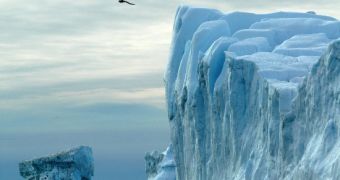The old piece of advice that one must always try and outdo themselves appears to have landed on the wrongest of ears. Thus, the Jakobshavn Glacier, which was already considered to be one of Greenland's fastest – if not the fastest – is now said to have reached record-breaking moving speeds.
In a paper published in the journal The Cryosphere this past February 3, researchers working with the University of Washington and the German Space Agency detail how, in the summer of 2012, said body of ice found itself traveling at a speed of 46 meters (almost 151 feet) per day.
This speed is the equivalent of 17 kilometers (about 10.56 miles) per year, and represents a record not just for Greenland, but also for the Antarctica.
As detailed on the official website for the European Geosciences Union, said flow rate appears to be the fastest that has until now been documented by science.
“We are now seeing summer speeds more than 4 times what they were in the 1990s on a glacier which at that time was believed to be one of the fastest, if not the fastest, glacier in Greenland,” says Ian Joughin, researcher Ian Joughin with the Polar Science Center at the University of Washington explains.
“We know that from 2000 to 2010 this glacier alone increased sea level by about 1 mm [some 0.04 inches]. With the additional speed it likely will contribute a bit more than this over the next decade,” the researcher goes on to explain.
After closely monitoring the glacier over the years 2012 and 2013, specialist Ian Joughin and his colleagues found that its average annual speedup for the period taken into consideration was about 3 times greater than the one documented back in the 1990s.
This happened despite the fact that the body of ice does not move as fast during winter as it does during the summer months, the researcher say.
In case anyone was wondering, the glacier's gradually building up speed is not due to a sugar rush, but a consequence of the fact that the Arctic region is getting warmer.
As the scientists who carried out this investigation explain, an increase in local weather temperatures has caused the glacier's calving front to shrink to a considerable extent.
More precisely, in the years 2012 and 2013, the calving front was documented to have retreated about 1 kilometer (roughly 0.62 miles miles) more than it did in previous years. This means that the body of ice no longer sits on a bed of rocks that might slow it down.
“As the glacier’s calving front retreats into deeper regions, it loses ice – the ice in front that is holding back the flow – causing it to speed up,” Ian Joughin says.
Based on evidence at hand, the researchers have reasons to believe that the glacier will continue to retreat, maybe even speed up, in the years to come.

 14 DAY TRIAL //
14 DAY TRIAL //